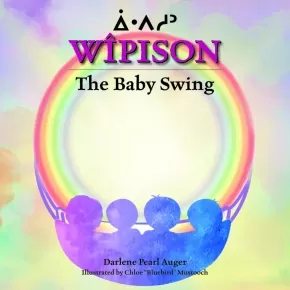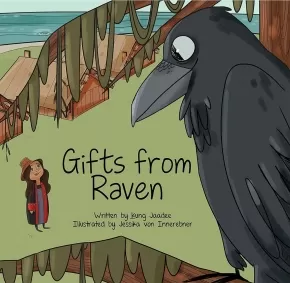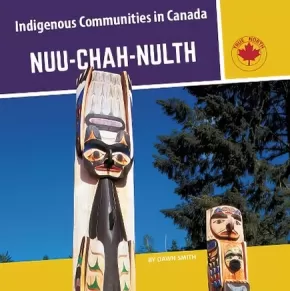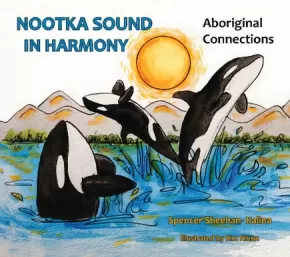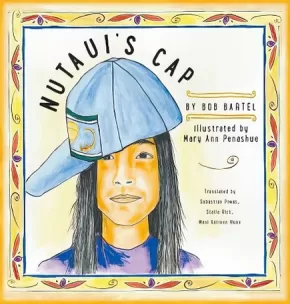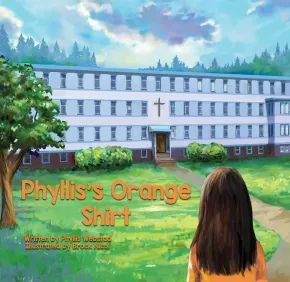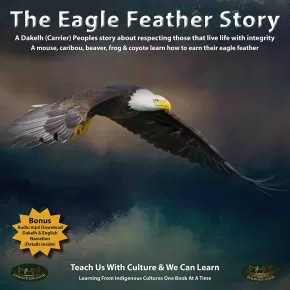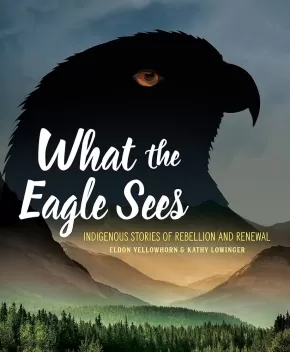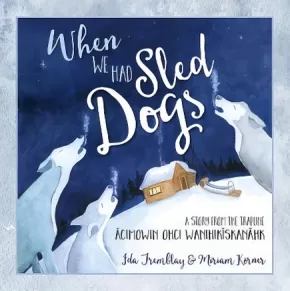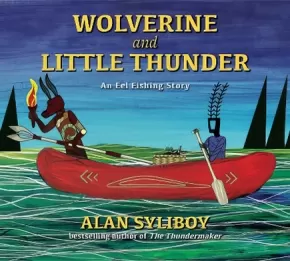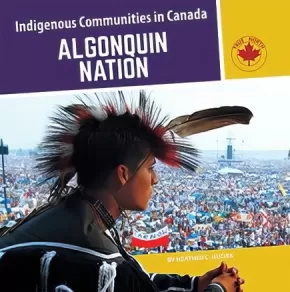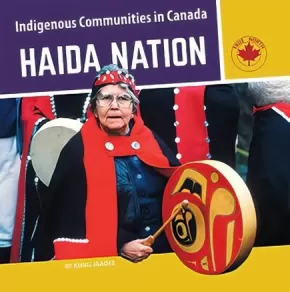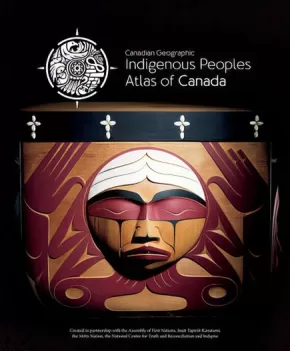
First Nations
76
-
90
of
179 Results;
Sort By
Go To
of 12
Wîpison: The Baby Swing
$9.95
Format:
Paperback
Text Content Territories:
Indigenous Canadian; First Nations; Cree (Nehiyawak);
ISBN / Barcode: 9781926696690
Synopsis:
Synopsis:
This story tells of the origin of the baby swing in the Cree (Nehiyaw) tradition. Morning Star’s mother is bringing home a new baby, so Nôkhom (her grandmother) and her father are making a swing for the baby. Grandmother tells Morning Star the legend of how Grandmother Earth brought materials for the swing to a young woman named White Flower who had been left to care for many babies while the parents were off hunting. White Flower was in tears because the babies would not stop crying, so she prayed to the grandmothers in Spirit World for help. When White Flower and Grandmother Earth put the babies in the swings, they calmed down and White Flower was able to get her chores done.
Educator & Series Information
Recommended for ages 6 to 12.
This book is part of the Little Women's Lodge Stories series.
Additional Information
32 pages | 6.00" x 9.00" | Paperback
Gifts from Raven
$11.95
Artists:
Format:
Hardcover
Text Content Territories:
Indigenous Canadian; First Nations; Haida;
ISBN / Barcode: 9781989122198
Synopsis:
Synopsis:
In this book, Gifts From Raven, Kung Jaadee a Haida storyteller, shares with us that Raven has given each person a special gift to share with the world. That gift is their unique talent or passion.
Reviews
"This story opens opportunities for discussions about generosity, community, diversity, unique talents, and helping others. This resource also supports learning about traditional Indigenous uses of natural resources in Social Studies and Science. Gifts from Raven is suitable as an enjoyable read-aloud for early primary students, and as an independent read for students in grades two and up. This resource features a short guide to Haida words with a visual for each." - Canadian Indigenous Books for Schools 2020/2021
Educator Information
This is an adaptation of her book Raven’s Feast for a younger audience.
A page at the back of the book includes a few words in Haida and how to say them.
Suggested for ages 4-6.
Included in the Canadian Indigenous Books for Schools 2020/2021 resource list as being useful for grades K-1 in the areas of Social Studies, Science, and Language Arts.
This book is available in French: Les cadeaux du corbeau
Additional Information
34 pages | 9.00" x 8.00"
Indigenous Communities in Canada: Nuu-Chah-Nulth
$14.95
Format:
Paperback
Text Content Territories:
Indigenous Canadian; First Nations; Nuu-chah-nulth (Nootka);
ISBN / Barcode: 9781773086392
Synopsis:
Synopsis:
This book explores the Nuu-Chah-Nulth.
Educator & Series Information
This book is part of the Indigenous Communities in Canada series.
Additional Information
24 Pages
Nootka Sound In Harmony: Aboriginal Connections
$14.95
Artists:
Format:
Paperback
Text Content Territories:
Indigenous Canadian; First Nations; Nuu-chah-nulth (Nootka); Mowachaht-Muchalaht ;
ISBN / Barcode: 9781775301936
Synopsis:
Synopsis:
Métis author, Spencer Sheehan-Kalina, uses poetry to highlight the beauty of the Nootka Sound and the animals that live there, with Aboriginal connections to the poem's content. Learn all about the traditional harvesting of the land plants and sea life by Nootka Sound's Indigenous people- the Mowachaht/Muchalaht. In addition, young readers will learn the Indigenous words of the animals that live in the Nootka Sound area. The Aboriginal connections in this children's book align with the BC curricular competencies of kindergarten to grade 3.
Nootka Sound in Harmony was released to coincide with the 2019 Year of Indigenous Languages.
Educator Information
Indigenous Children's picture book - Ages 3-8
With appreciation for permissions and support from the Cultural Resource Centre committee and Chief Jerry Jack of the Mowachaht/Muchalaht First Nation in Tsaxan, BC.
Additional Information
8" x 8" | 32 pages
Nutaui's Cap
$22.95
Artists:
Format:
Hardcover
Text Content Territories:
Indigenous Canadian; First Nations; Innu (Montagnais-Naskapi); Sheshatshiu Innu;
ISBN / Barcode: 9781927917244
Synopsis:
Synopsis:
Without warning, a deafening boom drove us to the ground, even Nutaui. I heard my heart pound hard against my chest. Seconds later another earsplitting blast struck us.
A moving story of protest and determination, Nutaui's Cap tells of a young Innu girl, Nanas. The low-level flying of NATO supersonic jets disrupts her family's traditional way of life, and endangers both them and the wildlife they depend upon, so Nanas' father and the other members of the Sheshatshiu community decide to protest by occupying the military's runways. Nanas is proud and eager to join in the social action, but then her father is arrested. Nanas has little to comfort her except his well-worn ball cap, and the promise of the land itself that the resilience, wisdom, and strength of the Innu people will one day triumph.
This true account of one small moment in the years-long struggle of the Innu people against NATO and the Canadian government brings to light the on-going fight for Innu rights on their own unceded land. Author Bob Bartel, an activist and volunteer, participated in the efforts to stop those NATO practice flights; he learned Nanas's story from her aunt and has Nanas's permission to tell the story. Bartel writes with care, simplicity, and deep awareness; he portrays with both power and subtlety the struggle as seen from a child's perspective.
Illustrations by acclaimed Innu artist Mary Ann Penashue capture the gentle relationship between Nanas and her father, and highlight the beauty and dignity of her people's culture. Her blending of traditional imagery with modern technique offers a visually rich and compelling accompaniment to Bartel's text.
Educator Information
Compelling story about Innu protests as seen from the perspective of child.
Author Bob Bartel, an activist and volunteer, participated in the efforts to stop those NATO practice flights; he learned Nanas's story from her aunt and has Nanas's permission to tell the story.
Nutaui's Cap has been translated into two dialects of Innu-aimun, both of which appear alongside the English. Some Innu-aimun words are also integrated into the English text; a glossary is provided. A map of the locations and a historical afterword, offering further context, are included as well.
Translated by Stella Rich, Sebastian Piwas, and Mani Katinen Nuna, with Laurel Anne Hasler, Penash Rich, and Marguerite MacKenzie
This book is a co-publication with Mamu Tshishkutamashutau Innu Education.
Recommended for ages 6 to 12.
Additional Information
68 pages | 9.00" x 9.00"
Phyllis's Orange Shirt
$11.95
Artists:
Format:
Hardcover
Text Content Territories:
Indigenous Canadian; First Nations; Salish; Interior Salish; Secwepemc (Shuswap); Stswecem'c Xgat'tem;
ISBN / Barcode: 9781989122242
Synopsis:
Synopsis:
When Phyllis was a little girl she was excited to go to residential school for the first time. Her Granny bought her a bright orange shirt that she loved and she wore it to school for her first day. When she arrived at school her bright orange shirt was taken away. This is both Phyllis Webstad's true story and the story behind Orange Shirt Day which is a day for us all to reflect upon the treatment of First Nations people and the message that 'Every Child Matters'.
Educator Information
Phyllis's Orange Shirt is an adaptation of The Orange Shirt Story which was the best selling children's book in Canada for several weeks in September 2018. This true story also inspired the movement of Orange Shirt Day which could become a federal statutory holiday. A page of information about this day is included at the end of the book. A short author biography is also included.
Adapted for ages 4-6.
Recommended in the Canadian Indigenous Books for Schools 2020/2021 resource list for grades K-1 in the areas of English Language Arts and Social Studies.
This book is available in French: Le chandail orange de Phyllis
Additional Information
30 pages | 9.00" x 8.00"
Spirit Bear: Honouring Memories, Planting Dreams: Based on a True Story
$12.95
Artists:
Format:
Paperback
Text Content Territories:
Indigenous Canadian;
ISBN / Barcode: 9781775191490
Synopsis:
Synopsis:
Spirit Bear: Honouring Memories, Planting Dreams is the latest addition to the award-winning picture book series written by Order of Canada recipient Cindy Blackstock (Gitxsan Nation) and illustrated by Amanda Strong (Michif)!
Spirit Bear is on his way home from a sacred ceremony when he meets Jake, a friendly dog, with a bag full of paper hearts attached to wood stakes. Jake tells Spirit Bear that school children and residential school survivors will plant the hearts when a big report on residential schools called the Truth and Reconciliation Commission (TRC for short) is shared. The TRC will have Calls to Action so we can all help end the unfairness and make sure this generation of First Nations, Métis, and Inuit children grow up healthy and proud!
Educator & Series Information
Recommended for ages 6 to 12.
This book is part of the Spirit Bear series.
This book is available in French: Spirit Bear: Rendre hommage aux souvenirs, semer des rêves: Basé sur une histoire vraie
Additional Information
66 pages | 8.25" x 8.25"
The Eagle Feather Story
$18.95
Artists:
Format:
Paperback
Text Content Territories:
Indigenous Canadian; First Nations; Dene; Dakelh (Carrier);
ISBN / Barcode: 9781926852256
Synopsis:
Synopsis:
The Eagle Feather Story is a beautiful and ancient Dakelh (Carrier Peoples) story about learning to respect people who live their lives with integrity. The story features both the Dakelh and English languages. There is also sections that provide readers with an overview of the Dakelh culture, history and territory. For all ages.
The Eagle Feather Story utilizes concepts from the Dakelh culture to teach about respecting each other and our Mother Earth. The story is beautifully illustrated and features creatures from the Dakelh territory as characters who struggle, but eventually, learn to embody the characteristics and principles that we all strive to live by. The Eagle Feather Story is a tale that encourages people, young and older too, to try to be the best they can be.
Educator Information
This a picture book that is recommended for all ages by its publisher.
Dual-language in Dakelh and English languages.
Storyteller: Francois Prince
Dakelh Language & Translations: Francois Prince and Aggie Anderson
Cultural Advisors: Leona Prince, Mark Barfoot, Kelly Brownbill
Includes a page of questions at the end of the book, entitled "Thoughts For Inquisitive Minds", for children to answer. These questions and discussion prompts relate to the book's content and prompt further conversation, learning, and inquiry.
Additional Information
Approx. 25 pages
The Grizzly Mother
$23.00
Artists:
Format:
Hardcover
Text Content Territories:
Indigenous Canadian; First Nations; Gitxsan (Gitksan);
ISBN / Barcode: 9781553797760
Synopsis:
Synopsis:
An engaging look at how the animals, people, and seasons within an ecosystem are intertwined.
To the Gitxsan people of Northwestern British Columbia, the grizzly is an integral part of the natural landscape. Together, they share the land and forests that the Skeena River runs through, as well as the sockeye salmon within it. Follow mother bear as she teaches her cubs what they need in order to survive on their own.
The Mothers of Xsan series uses striking illustration and lyrical language to bring the poetry of the Xsan ecosystem to life.
Awards
- Animal Behavior Society's Outstanding Children's Book Award
- 2020 Manuela Dias Design and Illustration Awards, Children's Illustration winner
Educator & Series Information
Recommended for ages 9 - 12.
This is the second book in the Mother of Xsan series, which uses striking illustration and lyrical language to bring the poetry of the Xsan ecosystem to life.
Recommended in the "Canadian Indigenous Books for Schools 2019-2020" resource list as being useful for students in grades 2-5 in these subject areas: English Language Arts, Science, Social Studies.
Additional Information
32 pages | 6.50" x 10.00"
What the Eagle Sees: Indigenous Stories of Rebellion and Renewal (PB)
$16.95
Format:
Paperback
Text Content Territories:
Indigenous;
ISBN / Barcode: 9781773213286
Synopsis:
Synopsis:
"There is no death. Only a change of worlds.” —Chief Seattle [Seatlh], Suquamish Chief
What do people do when their civilization is invaded? Indigenous people have been faced with disease, war, broken promises, and forced assimilation. Despite crushing losses and insurmountable challenges, they formed new nations from the remnants of old ones, they adopted new ideas and built on them, they fought back, and they kept their cultures alive.
When the only possible “victory” was survival, they survived.
In this brilliant follow up to Turtle Island, esteemed academic Eldon Yellowhorn and award-winning author Kathy Lowinger team up again, this time to tell the stories of what Indigenous people did when invaders arrived on their homelands. What the Eagle Sees shares accounts of the people, places, and events that have mattered in Indigenous history from a vastly under-represented perspective—an Indigenous viewpoint.
Reviews
“A standout overview . . . Visually engaging . . . a fine introduction . . . Sections in each chapter labeled “Imagine” are especially powerful in helping young readers empathize with Indigenous loss. Essential.” — Kirkus Reviews, *starred review
“A worthy and important addition to the historical record.” — Booklist, *starred review
“A brilliant introduction . . . An important read for everyone eleven years and older. It should be mandatory reading for all educators.” — Library Matters
The combination of modern and historical insight is extremely effective. A valuable resource for anyone seeking to learn more about Indigenous history and a vital purchase for all collections.”— School Library Journal, *starred review
Educator Information
Recommended for ages 11+.
Recommended in the Canadian Indigenous Books for Schools 2020/2021 resource list for grades 6 to 12 in these areas: Applied Design, English Language Arts, Social Studies, and Social Justice.
Additional Information
120 pages | 7.50" x 9.25" | Paperback
When We Had Sled Dogs: A Story from the Trapline - ācimowin ohci wanihikīskanāhk (HC) (4 in Stock)
$22.95
Artists:
Format:
Hardcover
Text Content Territories:
Indigenous Canadian; First Nations; Cree (Nehiyawak);
ISBN / Barcode: 9781988783390
Synopsis:
Synopsis:
When We Had Sled Dogs: A Story from the Trapline - ācimowin ohci wanihikīskanāhk takes readers young and old on a journey into the past when dog teams were part of the traditional way of life in Northern Saskatchewan. Inspired by Elder Ida Tremblay’s childhood memories, and told in English with Woodland Cree words and phrases, the story follows the seasonal cycle of trapline life.
Educator Information
Recommended for ages 5 - 10.
Delivered in English with Woodland Cree words and phrases.
This resource is recommended in the Canadian Indigenous Books for Schools 2020/2021 resource list for grades K to 4 for use in these areas: Social Studies, English Language Arts, and Career Education.
Additional Information
|
Wolverine and Little Thunder: An Eel Fishing Story (PB) (2 in stock, In reprint )
$14.95
Artists:
Format:
Paperback
Text Content Territories:
Indigenous Canadian; First Nations; Mi'kmaq;
ISBN / Barcode: 9781774710906
Synopsis:
Synopsis:
Celebrated Mi'kmaw artist behind The Thundermaker returns with a story about friendship and the importance of traditional knowledge.
From the bestselling creator of The Thundermaker comes another adventure featuring Little Thunder and Wolverine — a trickster, who is strong and fierce and loyal. The two are best of friends, even though Wolverine can sometimes get them into trouble. Their favourite pastime is eel fishing, whether it's cutting through winter ice with a stone axe or catching eels in traditional stone weirs in the summer. But that all changes one night, when they encounter the giant river eel — the eel that is too big to catch. The eel that hunts people!
At once a universal story of friendship and problem-solving, Wolverine and Little Thunder is a contemporary invocation of traditional Mi'kmaw knowledge, reinforcing the importance of the relationship between the Mi'kmaq and eel, a dependable year-round food source traditionally offered to Glooscap, the Creator, for a successful hunt.
Educator Information
Recommended ages: 4-8
Additional Information
40 pages | Paperback
Indigenous Communities in Canada: Algonquin Nation (4 in Stock)
$14.95
Format:
Paperback
Text Content Territories:
Indigenous Canadian; First Nations; Anishinaabeg; Algonquin;
ISBN / Barcode: 9781773083827
Synopsis:
Synopsis:
A book about the Algonquin Nation.
Educator & Series Information
This book is part of the Indigenous Communities in Canada series.
Additional Information
24 Pages
Indigenous Communities in Canada: Haida Nation
$14.95
Format:
Paperback
Text Content Territories:
Indigenous Canadian; First Nations; Haida;
ISBN / Barcode: 9781773083841
Synopsis:
Synopsis:
A book about the Haida Nation.
Educator & Series Information
This book is part of the Indigenous Communities in Canada series.
Additional Information
24 Pages
Indigenous Peoples Atlas of Canada
$99.99
Format:
Hardcover
Text Content Territories:
Indigenous Canadian; Métis; Inuit; First Nations;
ISBN / Barcode: 9780986751622
Synopsis:
Synopsis:
Indigenous perspectives much older than the nation itself shared through maps, artwork, history and culture.
The Royal Canadian Geographical Society, in partnership with Canada's national Indigenous organizations, has created a groundbreaking four-volume atlas that shares the experiences, perspectives, and histories of First Nations, Inuit and Métis peoples. It's an ambitious and unprecedented project inspired by the Truth and Reconciliation Commission's Calls to Action. Exploring themes of language, demographics, economy, environment and culture, with in-depth coverage of treaties and residential schools, these are stories of Canada's Indigenous Peoples, told in detailed maps and rich narratives.
This extraordinary project offers Canada a step on the path toward understanding.
The volumes contain more than 48 pages of reference maps, content from more than 50 Indigenous writers; hundreds of historical and contemporary photographs and a glossary of Indigenous terms, timelines, map of Indigenous languages, and frequently asked questions. All packaged together in a beautifully designed protective slipcase.
Educator Information
Recommended for ages 13+.
The Indigenous Peoples Atlas of Canada includes a four volume print atlas, an online atlas, an app, and more!
Additional Information
322 pages | 10.50" x 12.87"
Sort By
Go To
of 12

